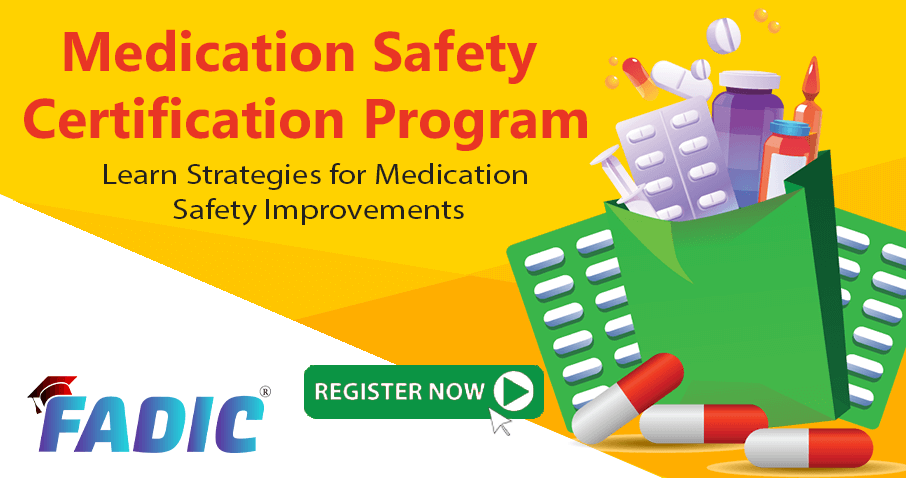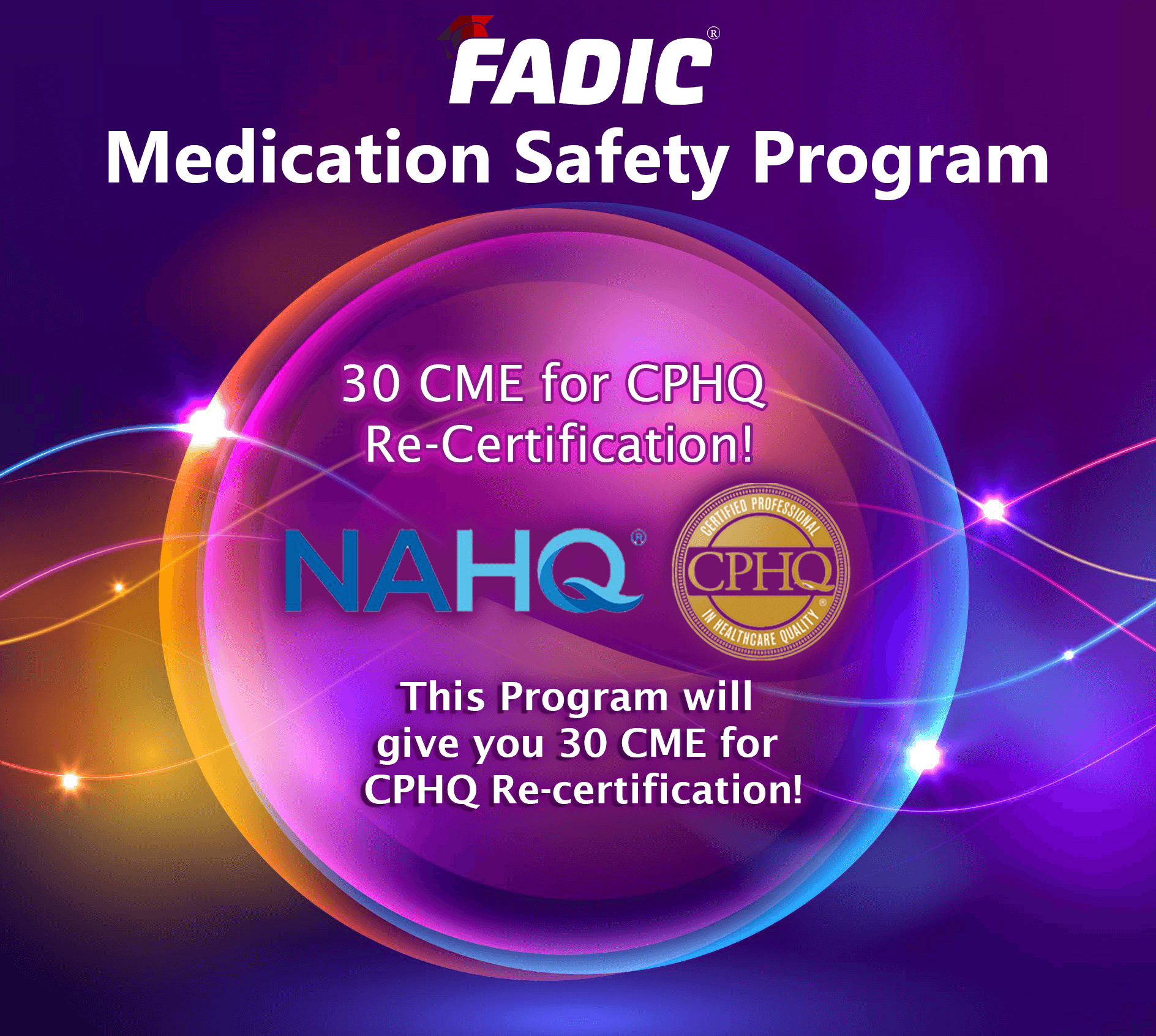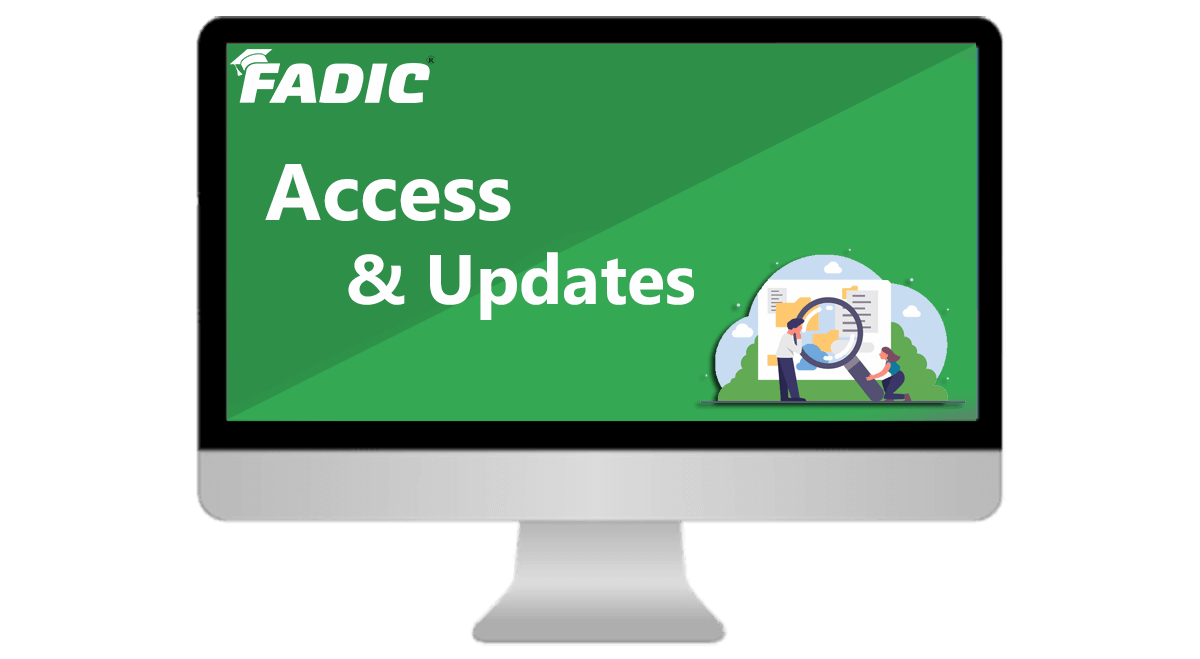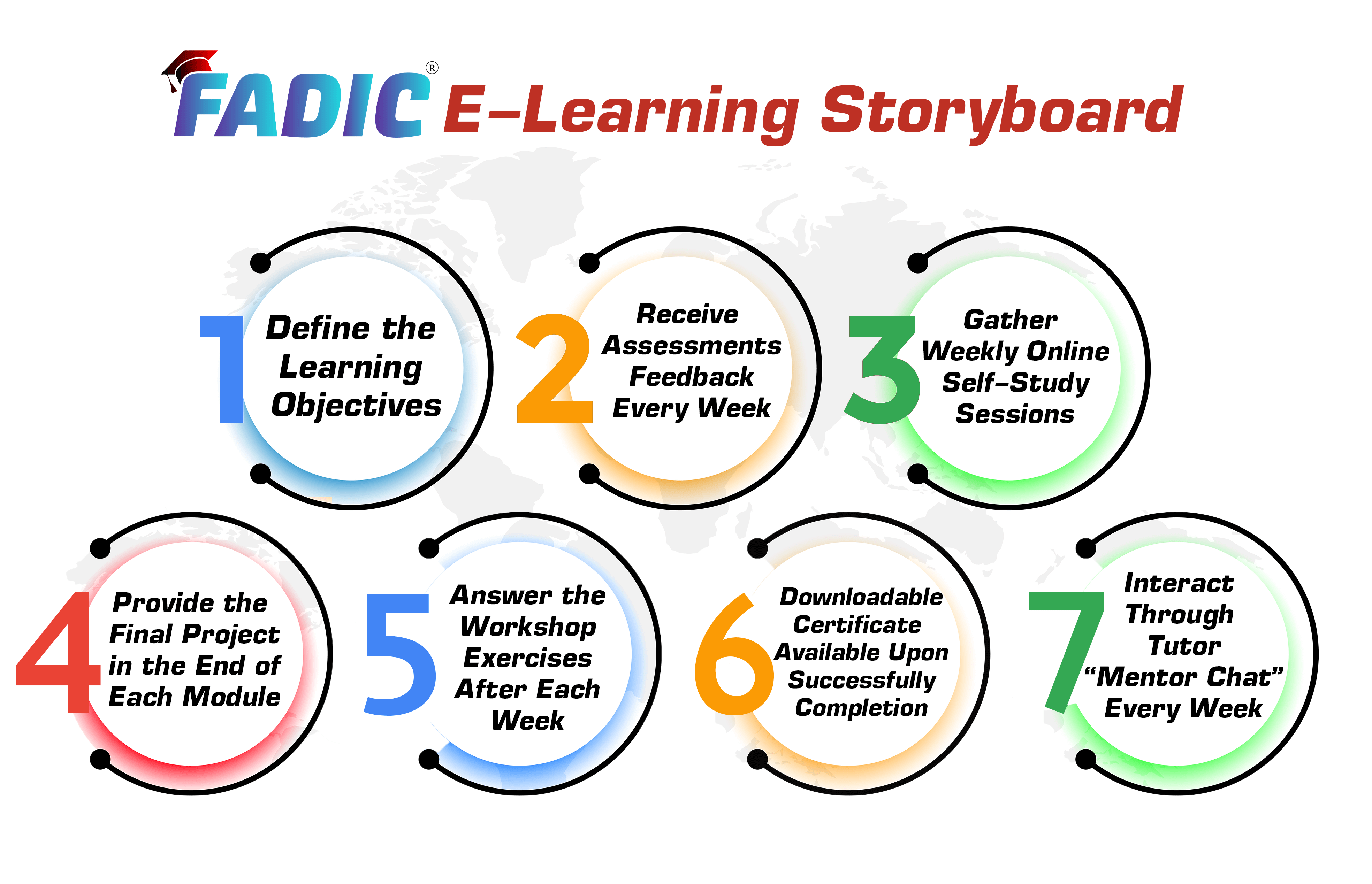
Overview
Medication Safety Course Certification

Medication Safety Course Certification Program Outlines
- Leadership
- Just Culture
-
Medication management
- Medication Errors
- Pharmacovigilance/adverse drug reactions
- Accreditation standards of medication management
- Patient Safety in a medication safety course
- Performance and Process Improvement
- Risk Assessment
Who Should Attend the medication safety course certificate?
- Healthcare Leaders and Administrators (Medicine, Nursing, Quality Administration)
- Accreditation Officers, Risk Managers, Case Managers, Quality Leader, Officers and Coordinators.
- The Coordinators are among the Clinicians (Physicians, Senior Nurses, Health Technicians, etc..)
- Allied Health Professionals (Pharmacy, Radiology, Laboratory, etc..)
- Healthcare professionals interested in managerial or quality jobs
| What You Will Get Every Week (Lesson Planning) | |||
| Online Lesson | Workshop / Project | Mentor Support | Reviewer |
| (2-3 Hours) per week | (60 Minutes) per week | Every week |
Review the answers with feedback
|
A fee for a medication safety certificate includes:
- Digital coloured handouts
- Qualified instructor with > 90% passing CPHQ certification/recertification
- 10 Workshop questions
- Extra References includes > 25 e-B00ks
- Drug information flashcards > 100 summarised drug cards
- Black box list of 2019 booklet
- Adverse drug booklet
- 30 Credit Hours (CME) for CPHQ Recertification
- > 50 Infographics
With the FADIC medication safety certificate program, you Will Have…

Access and Updates
The access to the research school will continue for 24 months from the initial registration time, including all updates, handouts and videos.

Learn with FADIC Mentorship Reviewer System
You will have your mentor in the medication safety certificate, who will facilitate the learning journey in clinical research.
Additionally, answer all your questions. Further, the reviewer will review all your projects & workshop.

Download all Handouts and print them it.
You will be able to study and work on your own properly in the medication safety certificate program.

You will get FADIC Drug Information Flash Cards Book For Free after Registration.

Finally, Get your Certificate from FADIC
Module 1
Scope and Background of Medication Safety
- What is Medication Safety?
- Medication safety terms in a medication safety course
- Identify medication safety risks
- Common types and causes of medication errors
- Difference between active and latent failures
- Strategies for medical error improvement (IOM)
- System causes of medication errors
- Key Elements of Medication Use System (ISMP)
Module 2
Setting the Medication Safety Agenda
- How accreditation organisations include medication safety,
ismp.
- Medication Management and Use
-
Medication errors
- Essential Safety Requirements
- Process to medication error analysis
- Adverse Drug Reaction
- FADIC Fast Report Card in a medication safety course
- Pharmacovigilance
Module 3
Effective Change Management Principles
- What is Change Management?
- Medication Safety Strategic Plan
- Change Management Plan to Reduce Medication Errors
- A guide to organisational transformation
- John Kotter’s 8-Step Change Model
- Diffusion of innovation theory
- 10 Principles of Change Management
- Role of the Medication Safety Leader
- Skills core to the TEAM STEPPS® framework
- Six Sigma, Lean, PDCA, and Kaizen Model
Module 4
The Impact of Culture on Safety
- A Framework for High-Reliability Organizations in Healthcare
- The 5 Key Concepts of High-Reliability Organizations (HRO)
- Culture of Safety in HRO in a medication safety course
- A Blame-Free Culture Versus A Punitive Culture
- Examples of a Blame-Free Culture
Module 5
Establishing a Just Culture
- Compare the two critical sides of Just Culture.
- Manage Risk, Build a Just Culture in a medication safety course
- Patient Safety Culture and the Second Victim Phenomenon
- The Value of establishing a rapid response team
- Example 1 of Rapid Response Team
- Example 2 of Rapid Response Team
Module 6
Managing Systems and Behaviours in a Just Culture
- Just Culture: The Key to Quality and Safety
- The Three Behaviors in a Just Culture
- Examples of risk behaviours in healthcare
- Tools for Human Error Reduction
- Confirmation Bias and Medication Safety
- First Order and Second Order Problem Solving
Module 7
Implementing and measuring a Just Culture
- The Just Culture Algorithm in a medication safety course
- How the algorithm can be misused (severity bias)
- Making Ends Meet: The Blunt End and Sharp End of Clinical Error
- The Swiss cheese model of safety incidents
- AHRQ Hospital Survey on Patient Safety Culture: User’s Guide
- Value of determining the safety climate in healthcare
Module 8
Reactive Versus Proactive Identification of Medication Risk
- Medication safety: Safety and Quality Improvement Guide
- IHI Global Trigger Tool for Measuring Adverse Events
- IHI Global Trigger Tool Training Resources
- Identify the significant steps of a Root Cause Analysis (RCA).
- From a reactive to a proactive safety approach in medication safety
- Failure Modes and Effects Analysis (FMEA) Tool
- Strengths and limitations of proactive & reactive medication safety risk
Module 9
Risk Reduction Strategies and Implementing Improvements Identification of Medication Risk
- Firstly, Risk Avoidance vs Risk Reduction: What’s the Difference?
- Secondly, Risk Assessment: The Basic Principles
- Risk Impact Assessment and Prioritisation
- Key Elements of the Risk Management Process
- Pros and cons related to competency development and assessment.
- Express appropriate techniques for patient safety Walk-Rounds™.
Module 10
Pulling it All Together to Successfully Implement and Sustain Safe Medication Practices
- Medication safety leader’s four significant areas of responsibility.
- FADIC is just a culture guide for medication Safety
- The 7 Steps to maintain medication safety
- Strategic plan for medication safety.
- The Medication Safety Committee
- Moreover, Medication Safety Officer Handbook
- Role of the Medication Safety Leader explained in a medication safety course.
For Medication Safety Program Syllabus and Lecturers, from this LINK. كورس السلامة الدوائية
Watch Now The Introduction Session of the Medication Safety Program Pharmacy Course
Hashtags
1. #medication safety
2. #medication safety course
3. #basic medication safety course
4. #medication safety definition
5. #medication safety pdf
6. #medication safety guidelines
7. # medication safety certificate
8. #medication safety officer
9. # medication safety quiz
10. #what is medication safety, 5 moments of medication, safety medication, safety committee
-
1- Medication Safety Terms
- Introduction of Medication Safety
- Historical Context of Medication Safety
- Medication Safety Among International Organization
- Medication Safety Terms
- Common Types and Causes of Medication Errors
- How to Improve Medication Safety?
- Difference Between Active and Latent Failures
- Strategies for Medical Error Improvement (IOM)
- ISMP Key Elements of Medication Use System
- Project 1 of Medication Safety Program
-
2- Medication Error, Adverse Drug Reaction, and Pharmacovigilance
- Medication Management and Use
- Essential Safety Requirements
- Medication Errors
- Adverse Drug Reactions
- FADIC Side Effect Report Card Booklet
- Pharmacovigilance
- Black Box Warning Medications List
- Project 2 of Medication Safety Program
- Drug Information Flashcards
-
3- High Reliability Organizations (HRO)
- A Framework for High-Reliability Organizations in Healthcare
- The 5 Key Concepts of High Reliability Organizations (HRO)
- Culture of Safety in HRO
- A Blame-Free Culture vs. Punitive Culture
- Examples of a Blame Free Culture
- Project 3 of Medication Safety Program
-
4- Establishing a Just Culture
- Compare the Two Key Sides of Just Culture
- Manage Risk, Build a Just Culture
- Patient Safety Culture and the Second Victim Phenomenon
- The Value of Establishing a Rapid Response Team
- Example 1 of Rapid Response Team
- Example 2 of Rapid Response Team
- Project 4 of Medication Safety Program
-
5- Implementing a Just Culture: Key to Quality and Safety
- Just Culture: The Key to Quality & Safety
- The Three Behaviors in a Just Culture
- Strategies for Reducing Human Error
- Confirmation Bias and Medication Safety
- First & Second Order Problem Solving
- Project 5 of Medication Safety Program
-
6- The Safety Climate in Healthcare
- The Just Culture Algorithm
- How the Algorithm Can be Misused
- The Blunt & Sharp End for Evaluation Clinical Error
- The Swiss Cheese Model of Safety Incidents
- AHRQ Hospital Survey on Patient Safety Culture
- Value of Determining The Safety Climate in Healthcare
- Project 6 of Medication Safety Program
-
7- Proactive VS. Reactive Medication Safety Risk Identification
- W7:1 Proactive VS. Reactive Medication Safety Risk Identification
- W7:2 FMEA (Failure Mode and Effects Analysis) Quick Guide
- W7:3 FMEA Example
- W7:4 A Step-By-Step Guide to Root Cause Analysis
- W7:5 Root Cause Analysis (RCA) Example
- W7:6 Quality Tools: Root Cause Analysis (RCA) and Failure Modes
- W7:7 RCA examples from the clinical practice during COVID19 pandemics
- Project 7 of Medication Safety Program
-
8- The Change Management Principles & Benefits
- W8:1 What is the Change Management & Benefits?
- W8:2 Values & Principles of Change Management
- W8:3 John Kotter 8-Step Change Model
- W8:4 Diffusion of Innovation & Change Spread
- W8:5 The 5 Stages of Innovation-Decision Process
- W8:6 Six Sigma – Lean – Kaizen Model
- W8:7 TeamSTEPPS- Team Strategies and Tools to Enhance
- W8:8 Common Pitfalls Encountered When Leading Change
- W8:9 Create & Integrate Medication Safety Strategic Plan
- Project 8 of Medication Safety Program
-
9- Risk Management Causes and Strategies
- W9:1 What is the Risk Management, Causes- How to Deal with it?
- W9:2 The 4 Risk Reduction Strategies
- W9:3 Example of Risk Reduction Strategy in High-Alert Medications
- W9:4 Rank Order of Risk Reduction Strategies Related to Sterile Compounding
- W9:5 Effective Risk Management Strategies
- W9:6 Risk Identification Tools – When to Use Each One
- W9:7 Pros and Cons Related to Competency Development and Assessment
- W9:8 Create Effective Dashboards- A Step-By-Step Guide
- W9:9 WalkRounds™ Patient Safety
- W9:10 Protocol Guide For Risk Management
-
10- A Day in the Life of a Medication Safety Officer
- W10:1 Medication Safety Leader Four Major Areas of Responsibility
- W10:2 Resources Available To Assist in the Development of a Medication Safety Plan
- W10:3 The 3 Challenges affect Medication Safety Strategic Plan
- W10:4 Differentiate Between Active Vs Latent Failures in the Case Study Event
- W10:5 Strategies to Prevent Similar Events in the Case Study from Occurring in Organizations
- W10:6 The Case for Medication Safety Officers – MSO
- W10:7 The Role of Medication Safety Committee
- W10:8 The Medicines Safety Improvement Program
- W10:9 A Day in the Life of a Medication Safety Officer
- W10:10 Medication Safety Officer – Getting Started
-
Your Certificate
- And Finally, Your Certificate…
Reviews
السلام عليكم ورحمه الله وبركاته كان من دواعي سروري معرفتي بهذا الكورس المميز بعدما تم تكليفي للعمل كمسؤول السلامة الدوائية في المستشفى الذي اعمل به قمت ببحث بسيط ووجدت هذا الكورس الأكثر من رائع والمتكامل امامي وبدات فيه وعلى مدار ١٠ اسابيع تعلمت الكثير والكثير من هذا البرنامج الاكثر من رائع وبدات بتطبيق بعض الافكار التي استفدت منها في البرنامج وتطبيقها في مكان العمل ، بالفعل برنامج متكامل واكثر من رائع .. أنصح الجميع والذين لهم رغبة فهم السلامة الدوائية بالحصول على الكورس .. وبالتوفيق جميعاً
Mazen Salehالسلام عليكم فريق فادك شكرا جزيلا علي هذا الكورس الشيق مع مجموعة من أكفأ المحاضرين المتواجدين دائماً للدعم والمساعدة في أي وقت وأتشوق للاشتراك معاكم في كورس جديد ان شاء الله
Maram MohamedThe Course of Medication Safety Officer was amazing and useful thanks a lot
Abduallah Mohammedالشكر للجميع علي هذا البرنامج والكورس الأكثر من رائع برنامج جدا مهم للصيادلة ويغطي اهم المواضيع عن Medication Safety و استفدت كثير من هذا الكورس خاصة هذا الكورس يقدمة دكاترة جدا مميزين والمواضيع التي تقدم مرتبة ويسهل وصول المعلومات للمتلقي .. تحياتي
Khaled Abdullahالسلام عليكم ورحمه الله وبركاته بصراحة الكورس رائع وبيحتوي علي كذا موضوع في مجال الجودة ومأمونية الدواء وبيفتح مدارك للمارس الصحي علشان يعرف ازاي تكون الممارسة الطبية في اطار تطبيق الجودة الصحية .. ديه ثالث مره اجدد شهادة ال CPHQ وشايفه ان الكورس متكامل لكل فروع الجودة وعملت ريفرش للست سنوات اللي فاتت
Fatma Elzahraa Ahmedبالنسبة للكورس جميل جدا وخصوصاً مع دكتورة رشا وبقترح وضع المزيد من الأمثلة خاصة علي المعلومات التي تحتاج ممارسة وموفقين إن شاء الله
Naif Mohamedشكرا لمجهودكم الرائع في فادك الكورس مفيد جداً و ملم بكل تفاصيل السلامة الدوائية و بوابة فادك الالكترونية سهلة الاستخدام
Maysoon Salim
 Log in
Log in Sign up
Sign up



